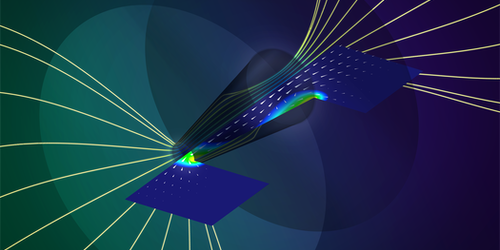Driving a One-Way Flow with a Two-Way Field
When it comes to manipulating fluid flows, less is sometimes more. Devices that move minute quantities of fluids through nanoscopic channels called nanopores have found applications in molecular sensing, DNA sequencing, and even power generation. Now Aaron Ratschow at the Technical University of Darmstadt in Germany and his colleagues propose a new method for driving nanoscale fluid flows that they say could give researchers greater control [1].
Ratschow and colleagues simulated the flow of an electrolyte moving between two reservoirs through a 100-nm-long, cone-shaped pore. They modeled this system under an electric field that switched direction and analyzed how the system responded to different switching frequencies.
The team observed that when the pore wall is positively charged, it accumulates a layer of negative ions and, on top of that, a layer of positive ions. The formation of this “electric double layer” (EDL) occurs after a time delay, and its growth rate depends on the speed of ion transport into the nanopore. When the electric field switches direction, the EDL dissipates and then reforms with the opposite polarity.
In a nanopore with parallel walls, the alternating field would drive the electrolyte back and forth with no net flow. But the team found that the conical nanopore has a symmetry-breaking effect that, coupled with the delayed EDL formation, results in a net flow toward the wide end. The flow reaches a maximum rate at a specific field frequency and falls to zero away from that frequency.
In previously demonstrated devices, electrolytes have been driven by constant, long-range electric fields that can encompass many nanopores. In the new design, the alternating field only needs to act locally, meaning adjacent nanopores can be controlled independently.
–Marric Stephens
Marric Stephens is a Corresponding Editor for Physics Magazine based in Bristol, UK.
References
- A. D. Ratschow et al., “Resonant nanopumps: AC gate voltages in conical nanopores induce directed electrolyte flow,” Phys. Rev. Lett. 129, 264501 (2022).




